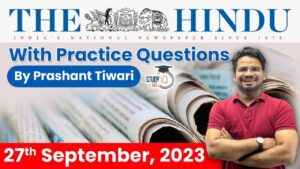The Hindu Newspaper Analysis for UPSC

The Hindu Newspaper Analysis 15 October 2022
- Globally, food and nutrition security continue to be undermined by the impacts of the COVID-19 pandemic, climate change, spiralling food inflation, conflict, and inequality.
- The Hunger Hotspots Outlook (2022-23) — a report by the Food and Agriculture Organization of the United Nations (FAO) and the World Food Programme (WFP) — forebodes escalating hunger, as over 205 million people across 45 countries will need emergency food assistance to survive.
- This year’s World Food Day (October 16) has been a reminder to ensure that the most vulnerable people within our communities have easy access to safe and nutritious food. The promise to end hunger by 2030 is possible only through collective and transformational action to strengthen agri-food systems; better production, better nutrition, a better environment, and a better life.
- India has had an inspiring journey towards better production and achieving self-sufficiency and is now one of the largest agricultural product exporters.
- By 2030, India’s population is expected to rise to 1.5 billion.
- One of India’s greatest contributions to equity in food is its National Food Security Act (NFSA) 2013 which anchors the Targeted Public Distribution System (TPDS), the PM POSHAN scheme (earlier known as the Mid-Day Meals scheme), and the Integrated Child Development Services (ICDS).
- An International Monetary Fund paper titled ‘Pandemic, Poverty, and Inequality: Evidence from India’ asserted that ‘extreme poverty was maintained below 1% in 2020 due to the Pradhan Mantri Garib Kalyan Anna Yojana (PMGKAY).
- National Food Security Act, 2013 (NFSA): It marks a paradigm shift in the approach to food security from welfare to rights based approach.
- NFSA covers 75% of the rural population and 50% of the urban population under:
- The eldest woman of the household of age 18 years or above is mandated to be the head of the household for the purpose of issuing ration cards.
- In addition, the act lays down special provisions for children between the ages of 6 months and 14 years old, which allows them to receive a nutritious meal for free through a widespread network of Integrated Child Development Services (ICDS) centres, known as Anganwadi Centres.
The Hindu Editorial Today

- ‘Inner party democracy’ is a favourite buzzword for Indian political commentators. Since 2019, there have been 27 articles in mainstream English media publications delivering sermons to the Congress about ‘internal democracy’.
- If inner party democracy was such a magic pill, why is it that no political party in India has embarked on it for so long?
- Translating grandiose ideas such as inner party democracy into action requires institutional capabilities, just as the Election Commission (EC) has to keep India a democratic republic.

- After Rajasthan and Chhattisgarh, Punjab is the latest State that has announced its plan to revert to the Old Pension Scheme (OPS).
- The OPS is an assured inflation-indexed monthly family pension till you (and your spouse) live(s).
- The OPS level is linked to the last pay you drew. The NPS is a corpus from which you can draw a pension after retirement. Its value is determined by the market prices in which the corpus is invested.
- the OPS is a fixed government expenditure irrespective of an economic slowdown or a stock market crash, which makes it a good counter-cyclical policy measure during a crisis.
What is the Defined Pension Benefit Scheme (old)?
- The scheme assures life-long income, post-retirement.
- Usually the assured amount is equivalent to 50% of the last drawn salary.
- The Government bears the expenditure incurred on the pension.
- The scheme was discontinued in 2004.
What is the National Pension System (NPS)?
- The Union government under PM Vajpayee took a decision in 2003 to discontinue the old pension scheme and introduced the NPS.
- The scheme is applicable to all new recruits joining the Central Government service (except armed forces) from April 1, 2004.
- On the introduction of NPS, the Central Civil Services (Pension) Rules, 1972 was amended.
National Pension System (NPS)
- About:
- It is being administered and regulated by Pension Fund Regulatory and Development Authority (PFRDA) set up under PFRDA Act, 2013.
- It is a voluntary retirement savings scheme laid out to allow the subscribers to make defined contributions towards planned savings thereby securing the future in the form of Pension.
- Under NPS, a unique Permanent Retirement Account Number (PRAN) is generated and maintained by the Central Recordkeeping Agency (CRA) for individual subscribers.
- It is an attempt towards a sustainable solution to the problem of providing adequate retirement income to every citizen of India.
- Eligibility for opening NPS account:
- A citizen of India, whether resident or non-resident, subject to the following conditions:
- Applicants should be between 18 – 70 years of age as on the date of submission of his/her application and should comply with KYC norms prescribed.
- A citizen of India, whether resident or non-resident, subject to the following conditions:

- Tamil Nadu has flagged serious security concerns over the increased presence of the People’s Liberation Army (PLA) of China in Sri Lanka.
- An alert issued by the State’s intelligence agency a few days ago said the activities of the Chinese in the neighbouring country is a concern to national security and called for intensified vigil along the coastline.
- The free movement of Chinese nationals in many parts of northern Sri Lanka, including Mullaitivu, Paruthitheevu, Analaitheevu, and Meesalai had triggered discontentment among Tamil fishermen.

- On average, India’s coal mines use only two-thirds of the capacity, with some large ones using only 1%, says an analysis by Global Energy Monitor (GEM), a firm that tracks utilisation of the fuel-source internationally.
- This suggests that 99 of India’s coal mine projects, expected to yield 427 million tonnes per annum (MTPA), under development are unnecessary, and opening new coal mines would not contribute to easing short-term supply-crunches.
- On the heels of Prime Minister Narendra Modi’s announcement of a net zero target of 2070, these new mines “… increase India’s likelihood of stranded assets, delay a clean energy future — and in the process pose irreversible impacts on India’s rural communities and environments for the sake of economically precarious mining ventures”, the report underlines.
- India is the second-largest importer of coal after China.
- Top 5 States in terms of total coal reserves in India are: Jharkhand > Odisha > Chhattisgarh > West Bengal > Madhya Pradesh.
On the basis of carbon content it can be classified into following three types:
- Anthracite: It is the best quality of coal with highest calorific value and carries 80 to 95% carbon content. It ignites slowly with a blue flame and found in small quantities in Jammu and Kashmir.
- Bituminous: It has a low level of moisture content with 60 to 80% of carbon content and has a high calorific value. Jharkhand, West Bengal, Odisha, Chhattisgarh and Madhya Pradesh have deposits of Bituminous.
- Lignite carries 40 to 55% carbon content and is often brown in colour with high moisture content thus, gives smoke when burnt. Rajasthan, Lakhimpur (Assam) and Tamil Nadu has deposits of Lignite.
- Peat is the first stage of transformation from wood to coal with low calorific value and less than 40% carbon content.

- The Ministry of Women and Child Development on Saturday rejected the Global Hunger Index (GHI) that ranked India 107 among 121 countries.
- As per the Ministry, the report lowers India’s rank based on the estimates of the Proportion of Undernourished (PoU) population.
- It elaborates that the U.S. Food and Agriculture Organisation (FAO) estimate is based on the ‘Food Insecurity Experience Scale (FIES)’ survey module that bears a sample size of 3,000 respondents.
- Authors of the report primarily refer to the United Nations’ Sustainable Development Goal 2 (SDG 2) that endeavours to achieve ‘Zero Hunger’ by 2030.
- The GHI score is computed using four broad indicators — undernourishment (measure of the proportion of the population facing chronic deficiency of dietary energy intake), child stunting (low height for age), child wasting (low weight for height) and child mortality (death of a child under the age of five).
Q) With reference to the electoral bonds, consider the following statements:
- Buyers can donate the bonds to a party of their choice and the bonds have to be cashed by the party through its verified account within 10 days.
- Bank of Baroda is the only bank authorised to sell electoral bonds.
Which of the above statements is/are correct?
- 1 only
- 2 only
- Both 1 and 2
- Neither 1 nor 2
चुनावी बांड के संदर्भ में, निम्नलिखित कथनों पर विचार करें:
- खरीदार अपनी पसंद की पार्टी को बांड दान कर सकते हैं और बांड को 10 दिनों के भीतर अपने सत्यापित खाते के माध्यम से पार्टी द्वारा भुनाया जाना चाहिए।
- बैंक ऑफ बड़ौदा इलेक्टोरल बॉन्ड बेचने के लिए अधिकृत एकमात्र बैंक है।
उपरोक्त में से कौन सा/से कथन सही है/हैं?
- केवल 1
- केवल 2
- दोनों 1 और 2
- न तो 1 और न ही 2
Explanation :
- The electoral bonds system was introduced in 2017 by way of a money bill introducing amendments in the Finance Act and the Representation of People Act.
- It was implemented in 2018.
- The electoral bonds are issued in multiples of Rs 1,000, Rs 10,000, Rs 1 lakh, Rs 10 lakh and Rs 1 crore.
- State Bank of India is the only bank authorised to sell electoral bonds.
- Buyers can donate the bonds to a party of their choice and the bonds have to be cashed by the party through its verified account within 15 days.
- No payment shall be made to any political party if the electoral bond is deposited after expiry of the validity period of 15 days.
- Eligible political parties are allotted a verified account by the Election Commission of India (ECI) and the electoral bond transactions can be made only through this account.
- Buyers of the bonds have to submit full KYC details at the time of buying. However, the beneficiary political party is not required to reveal the identity of the entity that has given it the bonds.
Q) Global Hunger Index (GHI) is published by:
- World Bank
- World Economic Forum
- Amnesty International
- None of the above
ग्लोबल हंगर इंडेक्स (GHI) किसके द्वारा प्रकाशित किया जाता है:
- विश्व बैंक
- विश्व आर्थिक मंच
- एमनेस्टी इंटरनेशनल
- उपरोक्त में से कोई नहीं
Explanation :
India has ranked 107 on the Global Hunger Index (GHI), 2022, out of 121 countries, lagging behind most south Asian countries.
- The Global Hunger Index (GHI) is a tool for comprehensively measuring and tracking hunger at global, regional, and national levels.
- It is prepared jointly by Irish aid agency Concern Worldwide and German organisation Welt Hunger Hilfe.
- GHI scores are based on the values of four component indicators:
- Undernourishment (share of the population with insufficient caloric intake),
- child stunting (the share of children under age five who have low height for their age, reflecting chronic under-nutrition),
- child wasting (acute under-nutrition in children under age five with low weight for their height),
- child mortality (the mortality rate of children under the age of five).
- The GHI score is calculated on a 100-point scale reflecting the severity of hunger, where zero is the best score (no hunger) and 100 is the worst.
Q) With reference to the Snow leopards, consider the following statements:
- Snow leopards are native to the alpine regions of Central Asia.
- It is listed as ‘critically endangered’ on the IUCN red list of threatened species.
Which of the above statements is/are correct?
- 1 only
- 2 only
- Both 1 and 2
- Neither 1 nor 2
हिम तेंदुओं के संदर्भ में निम्नलिखित कथनों पर विचार कीजिएः
- हिम तेंदुए मध्य एशिया के अल्पाइन क्षेत्रों के मूल निवासी हैं।
- इसे संकटग्रस्त प्रजातियों की IUCN लाल सूची में ‘गंभीर रूप से संकटग्रस्त’ के रूप में सूचीबद्ध किया गया है।
उपरोक्त में से कौन सा/से कथन सही है/हैं?
- केवल 1
- केवल 2
- दोनों 1 और 2
- न तो 1 और न ही 2
Explanation :
Wildlife officials in Arunachal Pradesh await results of a survey to ascertain the presence of the elusive snow leopard in the Namdapha National Park and Tiger Reserve.
- Snow leopards are native to the alpine regions of Central Asia.
- The 12 snow-leopard range countries are – Afghanistan, Bhutan, China, India, Mongolia, Kazakhstan, Kyrgyzstan, Nepal, Tajikistan, Pakistan, Russia and Uzbekistan.
- In India, snow leopards inhabit the higher Himalayan and trans-Himalayan region at an altitude between 3,000-5,400 metres.
- Snow leopard states are Jammu and Kashmir, Ladakh, Himachal Pradesh, Uttarakhand, Sikkim, and Arunachal Pradesh.
Conservation:
- It is listed as ‘Vulnerable’ on the IUCN red list of threatened species.
- It is protected under Schedule I of Wildlife Protection Act, 1972
- Also, it is listed on Appendix I of the Convention on International Trade of Endangered Species (CITES).
Q) With reference to the Direct Benefit Transfer scheme, consider the following statements:
- It was started on 1st January, 2019.
- Currently it functions under the NITI Aayog.
Which of the above statements is/are correct?
- 1 only
- 2 only
- Both 1 and 2
- Neither 1 nor 2
प्रत्यक्ष लाभ अंतरण योजना के संदर्भ में, निम्नलिखित कथनों पर विचार करें:
- इसे 1 जनवरी, 2019 को शुरू किया गया था।
- वर्तमान में यह नीति आयोग के तहत कार्य करता है।
उपरोक्त में से कौन सा/से कथन सही है/हैं?
- केवल 1
- केवल 2
- दोनों 1 और 2
- न तो 1 और न ही 2
Explanation :
IMF terms India’s Direct Benefit Transfer scheme, as a ‘logistical marvel’.
- The aim of DBT (Direct Benefit Transfer) is to transfer the benefits and subsidies of various social welfare schemes directly in the bank account of the beneficiary on time by bringing efficiency, effectiveness, transparency and also to eliminate the intermediary body.
- It was started on 1st January, 2013.
- It was created in the Planning Commission to act as the nodal point for the implementation of the DBT programmes.
- The Mission was transferred to the Department of Expenditure in July, 2013 and continue to function till 14.9.2015.
- To give more impetus, DBT Mission and matters related thereto has been placed in Cabinet Secretariat under Secretary (Co-ordination & PG) w.e.f. 14.9.2015.
- According to the government data, more than Rs 24.8 lakh crore has been transferred through Direct Benefit Transfer (DBT) mode since 2013.
Q) Living Planet Report 2022 is published biennially by:
- Centre for Science and Environment
- World Wide Fund for Nature (WWF)
- United Nations Environment Programme
- Earth justice
लिविंग प्लैनेट रिपोर्ट 2022 द्विवार्षिक रूप से किसके द्वारा प्रकाशित की जाती है:
- विज्ञान और पर्यावरण केंद्र
- वर्ल्ड वाइड फंड फॉर नेचर (WWF)
- संयुक्त राष्ट्र पर्यावरण कार्यक्रम
- पृथ्वी न्याय
Explanation :
According to Living Planet Report 2022, Wildlife populations decline by 69% in 50 years.
- The highest decline (94 per cent) was in the Latin America and the Caribbean region.
- Africa recorded a 66 per cent fall in its wildlife populations from 1970-2018 and the Asia Pacific 55 per cent.
- Freshwater species populations globally reduced by 83 per cent. Habitat loss and barriers to migration routes were responsible for about half of the threats to monitored migratory fish species.
- It identified six key threats to biodiversity — agriculture, hunting, logging, pollution, invasive species and climate change — to highlight ‘threat hotspots’ for terrestrial vertebrates.
- Mangroves continue to be lost to aquaculture, agriculture and coastal development at a rate of 0.13 per cent per year.
- Around 137 square kilometres of the Sundarbans mangrove forest in India and Bangladesh has been eroded since 1985.
Living Planet Report:
- It is published biennially by World Wide Fund for Nature (WWF).
- It is a comprehensive study of trends in global biodiversity and the health of the planet.
- The Living Planet Report 2022 is the 14th edition of the report.
Mains Practice Question:
Q) Do you agree with the view that “Collegium system requires reconsideration” ?(150 words)
क्या आप इस विचार से सहमत हैं कि “कॉलेजियम प्रणाली पर पुनर्विचार की आवश्यकता है”? (150 शब्द)


 The Hindu Newspaper Analysis 6 October 2...
The Hindu Newspaper Analysis 6 October 2...
 The Hindu Newspaper Analysis 30 Septembe...
The Hindu Newspaper Analysis 30 Septembe...
 The Hindu Newspaper Analysis 27 Septembe...
The Hindu Newspaper Analysis 27 Septembe...





















